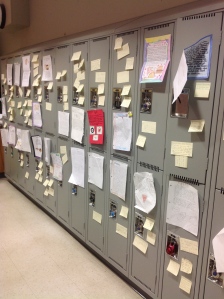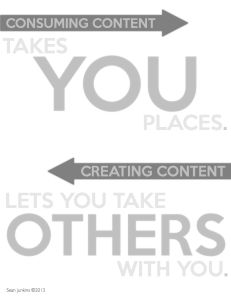I met with several colleagues today to discuss student blogging. I believe that student blogging is a great tool for Multimedia learning where the student becomes the curator and author of an educational experience. Last year was my first year hosting public student blogs, and I have been speaking about the game-changing nature of having students write for audiences beyond the classroom. We experienced exciting connections and global interactions that ignited a passion for exchanging ideas with others and writing for authentic purposes.
Today I spoke of the “Getting Started” portion of student blogs. I shared my rationale for hosting blogs and why I chose to have my students write publicly last year. I had previously hosted a private wiki for my students, where each child had their own space and as class we co-curated or shared common pages as well. This was a great little private gathering place that contributed to a positive sense of community and became a valuable resource. But, since our population was limited to our classroom, the conversation could only extend a short distance.
I shared several blogging tools and the teachers discussed their own purposes for student blogging. The biggest question was “What do you do with the child that won’t blog?” Because it happens! When the teachers thought about the question being asked of them, they all discovered a certain level of discomfort in being told that they must write publicly. One teacher suggested encouraging the use of a shared paper notebook for some students to write their blog posts in and seeking feedback or comments from other students, possibly even students from beyond their own classroom.
After discussing parent permissions and FOIPPA we moved on to initial starting activities. My favourite launch for blogging is asking my students to create paper blogs – an idea shared by Pernille Ripp. My goals for the paper blog experience is to show my students the idea of writing becoming public – viewable by anyone; and also the idea of using comments to engage in conversation. After the paper blogs are written by the students, they are posted onto the student’s lockers. We leave them up for several days encouraging students and guests to read each and every blog post. Students are given a stack of sticky notes to write comments on the paper blogs. We read several online blogs and comments and look for comments that create more dialogue. We called those comments “open” comments because they opened a discussion. “Closed” comments were comments that stopped a conversation or were difficult to reply to. Students were asked to write open comments, and “post” their sticky notes on the lockers with the blogs. Students were excited to be receiving comments and wanted to reply, so they learned about nesting their notes, or attaching their replies to the original comments so that the conversation could be read easily. The blogs were left up for about a week afterwards, and guests and students were welcome to continue commenting.
and also the idea of using comments to engage in conversation. After the paper blogs are written by the students, they are posted onto the student’s lockers. We leave them up for several days encouraging students and guests to read each and every blog post. Students are given a stack of sticky notes to write comments on the paper blogs. We read several online blogs and comments and look for comments that create more dialogue. We called those comments “open” comments because they opened a discussion. “Closed” comments were comments that stopped a conversation or were difficult to reply to. Students were asked to write open comments, and “post” their sticky notes on the lockers with the blogs. Students were excited to be receiving comments and wanted to reply, so they learned about nesting their notes, or attaching their replies to the original comments so that the conversation could be read easily. The blogs were left up for about a week afterwards, and guests and students were welcome to continue commenting.
We discussed how the students might choose to use their blogs and what content they may want to include, such as images, stories, reflections or classroom
 assignments. It becomes a personal platform for learning and sharing out. I shared one of my favourite quotes “Consuming content takes you places. Creating content lets you to take others with you” via @sjunkins.
assignments. It becomes a personal platform for learning and sharing out. I shared one of my favourite quotes “Consuming content takes you places. Creating content lets you to take others with you” via @sjunkins.
I believe that blogging becomes a great Mulimedia learning tool for our students because it can grow into a personalized learning tool and a platform from which to spring into new conversations with other interested parties on topics that may not be traditionally emphasized in our schools. Blogging bridges the learning at home/learning at school divide by opening a window between the two spaces. Students can share their knowledge on a variety of topics that may not otherwise come up. Blogging will also enable more students to share their learning in a manner that connects closely with their learning process. If they learned with Multimedia sources, it will be easy for students to not only credit these sources, but link out to share these resources for other interested learners. Using a blog as a reflective tool, a curation tool and a tool for discussion relates closely to Mayer’s Cognitive Theory of Multimedia Learning. A student blog can be a place to share out useful sources of information and it can also be a place where students make sense of the information that they are curating. This can be a collaborative effort, where they filter, organize and make meaning of new information through their conversations and posts. Blogging has been a great tool for #geniushour in my classroom, as students could reflect openly and seek help and guidance when they were taking initial steps on new topics.
I am excited that more classrooms will be blogging in my school this year! #geniushour has a strong foothold in our school and it will interesting to learn from these students as they engage in their inquiries.

Heidi, Your post is inspiring! What a great way to introduce students to the power of blogging! I love your choice in quotes! I am going to borrow it to post in my class! I am pretty sure my comment is a closed comment:) but I wanted you to know that you blog has inspired me to rethink the way I introduce blogging! Thanks for sharing!
LikeLike